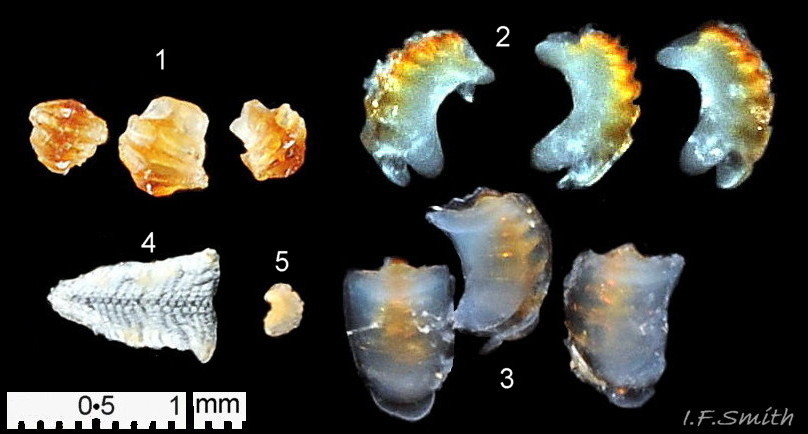1: ribbed inner face of three gizzard plates, stained brown, perhaps ferrous mineralization. In this view they look smaller than in 2 and 3 because they were shrunken and more strongly curved from being dried. Views 2 and 3 were in water.
2: side view of gizzard plates showing ribbed inner surface and concave smooth exterior face.
3: deeply concave, smooth, exterior face of gizzard plates.
4: broad radula with c.18 transverse rows of white teeth. Outline is triangular/lanceolate because rows at posterior are folded in. Each row has a central tooth flanked by a single lateral and c.8 to 9 marginal teeth on either side. This is expressed as a formula for this specimen as
9.2mm slug; 18X 8-9.1.1.1.8-9
This conforms with the examples in Thompson (1976) of:
4mm slug; 17X 4-5.1.1.1.4-5
18mm slug 18X 12-13.1.1.1.12-13
25mm slug 25X 18-19.1.1.1.18-19
5: pair of closely compressed jaws; only the upper one in image is visible.
The gizzard plates each had eleven ribs; large at posterior, tapering to very small at anterior. This accords with the 8-15 range for H. navicula in Malaquias and Cervera (2006) and with none of the other seven European species on their Table 1. The small ribs could be easily missed, especially if dried and shrunken.
The gizzard is located in the foregut where the three plates are bound into a bundle by strong muscles in the gut wall at this point. The tapered, curved anteriors of the plates form the opening of a funnel like arrangement through which all food must enter to be ground by the ribs. Radula and gizzard plates from specimen with body length 9.2mm and shell height 5.4mm. Dorset, England. September 2018. Leg. S. Trewhella.
References
Malaquias, M.A.E. and Cervera, J.L. 2006. The genus Haminoea (gastropoda: cephalaspidea) in Portugal, with a review of the European species. J. Moll. Stud., 72: 89–103 doi.org/10.1093/mollus/eyi052
Thompson, T.E. 1976. Biology of opisthobranch molluscs vol.1. London, Ray Society.

